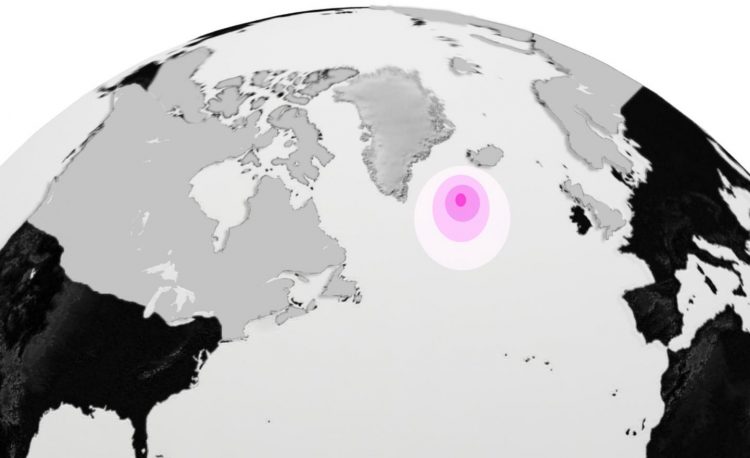'Ice age blob' of warm ocean water discovered south of Greenland

Greenland experienced several abrupt and brutal climate changes during the last ice age. But even during the coldest periods a blob of warm surface water existed nearby. Credit: M. Sojtaric/CAGE/colourbox.com
Extreme climate changes in the past Ice core records show that Greenland went through 25 extreme and abrupt climate changes during the last ice age some 20.000 to 70.000 years ago. In less than 50 years the air temperatures over Greenland could increase by 10 to 15 °C.
However the warm periods were short; within a few centuries the frigid temperatures of the ice age returned. That kind of climate change would have been catastrophic for us today. (link)
Ice core records from Antarctica also show climate changes in the same period, but they are more gradual, with less severe temperature swings.
The Nature Scientific Report study shows that an area of the Nordic Seas, just south of Iceland, followed the Antarctic pattern of warming and cooling. Which is strange since it is so close to Greenland.
“We had expected to see sudden climate changes. But sediment core records from the area show that the climate changes here were actually gradual, and quite identical to Antarctic climate changes.” says CAGE professor Tine Rasmussen, the principal author of the paper.
Gulf Stream holds the answers
Then, as now, the circulation of Atlantic Ocean, with currents such as the Gulf Stream, regulated transportation of heat to this area. Simply put, the surface currents transport heat from the southern and tropical Atlantic toward the North Atlantic.
” The Nordic seas between Norway and Greenland play a crucial role for the current patterns of the Atlantic Ocean. They act as a pump. Here the warm and salty surface water cools down during winter. It becomes heavy and is pumped down to the bottom before returning to the Atlantic, where it continues as a deep current all the way to the Antarctic region. ” co-author Erik Thomsen from Aarhus University ( link) points out.
Without this pump, the north-south current system would slow down considerably. Changes in this circulation can have a profound impact on the global climate system.
During the ice ages this circulation was assumed to work as a seesaw in the playground – going up and down in opposite directions with an axis somewhere around the equator. The idea is that when it warmed in the north, it cooled in the south and vice versa. But Rasmussen and colleagues indicate another scenario.
Rewriting the seesaw hypothesis
During the coldest periods of the last ice age the Nordic seas were covered with a permanent layer of sea ice. The pump stopped transporting the heat northward. The heat accumulated in the southern oceans. However, the warming was not restricted to the south.
” Our results show that it continued all the way to Iceland. The warming was slow and gradual, and happened simultaneously in both hemispheres. Little by little the warm Atlantic water penetrated into the Nordic sea underneath the ice cover. It melted the ice from below. Once the ice was gone, the pump started up again, bringing additional warm water into the Nordic seas. And we got a warmer period for 50 years. ” says Rasmussen.
Large ice sheets continued however, to cover the continents around the Nordic seas. In contact with the warm ocean water they started calving. This delivered icebergs and fresh water into the sea and caused a cooling down of the surface water. The seas were again frozen. And the pump slowed down.
The warm ocean blob of the ice ages rewrites the understanding of the ocean circulation systems, and how they affected the extreme climate changes of the past. The seesaw was actually more of a 'push and pull' system.
“There are no symmetrical processes in the north and the south – the climate changes were principally governed by simultaneous warming and the constant closing and re-opening of the sink pump in the Nordic seas” says Tine Rasmussen.
Media Contact
All latest news from the category: Earth Sciences
Earth Sciences (also referred to as Geosciences), which deals with basic issues surrounding our planet, plays a vital role in the area of energy and raw materials supply.
Earth Sciences comprises subjects such as geology, geography, geological informatics, paleontology, mineralogy, petrography, crystallography, geophysics, geodesy, glaciology, cartography, photogrammetry, meteorology and seismology, early-warning systems, earthquake research and polar research.
Newest articles

First-of-its-kind study uses remote sensing to monitor plastic debris in rivers and lakes
Remote sensing creates a cost-effective solution to monitoring plastic pollution. A first-of-its-kind study from researchers at the University of Minnesota Twin Cities shows how remote sensing can help monitor and…

Laser-based artificial neuron mimics nerve cell functions at lightning speed
With a processing speed a billion times faster than nature, chip-based laser neuron could help advance AI tasks such as pattern recognition and sequence prediction. Researchers have developed a laser-based…

Optimising the processing of plastic waste
Just one look in the yellow bin reveals a colourful jumble of different types of plastic. However, the purer and more uniform plastic waste is, the easier it is to…



